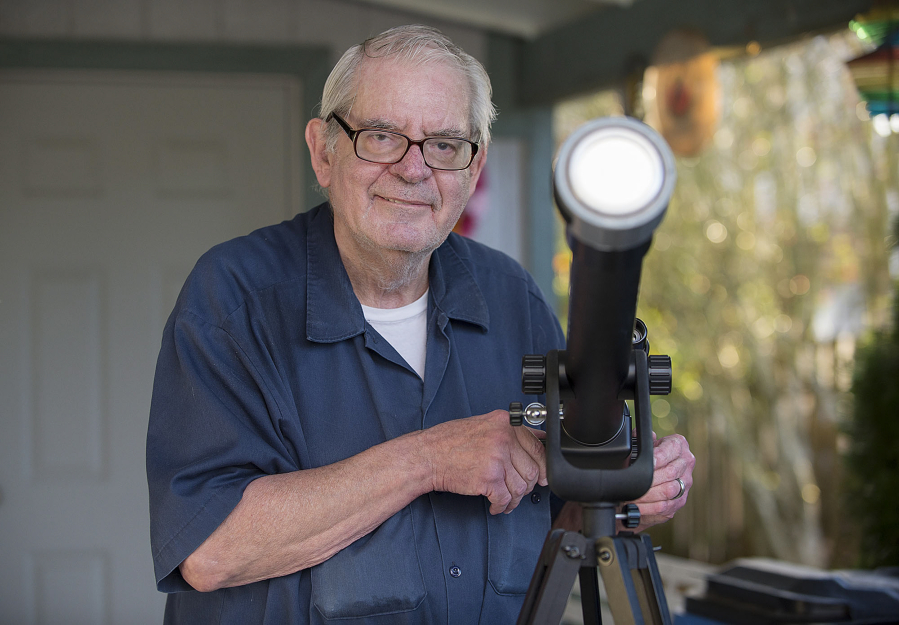The story of Stan Seeberg’s first total solar eclipse, in 1970, sounds like the end of the Mayan calendar.
Then, in Central Mexico, Seeberg saw the black disc of the moon slip over the sun, turning its fiery corona pink. The sky darkened. Phenomena known as shadow bands projected wriggling, out-of-focus worms onto a sheet at his feet.
“I imagine the ancients saw them but didn’t recognize them,” the 74-year-old said. “They were flickering along at a walking speed. That was amazing. I’m sure if there were buildings around they’d be all over the buildings and everything.”
Seeberg recalls the experience, and the other total solar eclipse he witnessed in 1991, with wide-eyed awe. The events only lasted minutes. But he retells the story in his home, near solar and lunar-themed pillows, a framed picture of the Andromeda Galaxy, and a tilted black telescope. There’s no question whether he’ll catch the total solar eclipse coming in August — the only question is where.
“I want to be able to see the shadow coming across the Cascades,” he said. “I don’t want to be on this side of the Cascades, because even in August you can get fog. I don’t want to chance that.”
The August total solar eclipse will be the first in the contiguous United States since 1979. The 71-mile-wide path will slant from northwestern corner of Oregon toward the southeastern corner of South Carolina. Time within the umbra, also known as the totality, is projected to last just 2 minutes and 41.6 seconds.
It’s no wonder then that available campsites along the corridor are just as fleeting. The Oregon Parks and Recreation Department announced late November that 1,200 campsites at state parks within the totality had sold out within an hour.
The eclipse will roll into Oregon at 10:15 a.m. starting around Depoe Bay on the coast, cross eastward toward Salem, Madras and John Day and exiting just north of Ontario.
Seeberg said not being in the totality is “close but no cigar.”
Gravitating toward astronomy
Seeberg’s fascination started at the age of 8, when his parents handed him a black, plastic telescope he would use to spot airplanes in the sky. His curiosity soon landed in outer space, and the challenge became finding the Messier objects, celestial bodies catalogued by French astronomer Charles Messier in the 18th Century.
He bounced around clerical jobs after graduating high school in Pasadena, Calif., but he gravitated toward jobs in stargazing. He was a guide at the Griffith Observatory, where he met the woman who would become his wife.
In the 1980s, Seeberg said, he was a successful telescope salesman with a Portland equipment company, meeting customers with a sales pitch that favored the experience over a product’s telescopic specs. He coached buyers based on what they wanted: Did they want to look at objects on land or up into space? What size did they want?
“I built up a huge telescope business for them,” he said. “There are many different kinds, many different styles. One decision you’d have to make: if you want a large telescope, do you want to haul it around? Do you want a small, portable telescope?”
Today he’s co-founder of Vancouver Sidewalk Astronomers. During years he was a greeter at Wal-Mart, he held stargazing parties in the retailers’ parking lot and showing kids the craters on the moon.
“I liked to show the moon at a star party if I can, because it’s right there in your face,” he said. “Out in the country, with no moon, you can glimpse quite a number of objects.”
During the total solar eclipse, Seeberg cautions any and all to protect their eyes. He’ll burn a coin purse with a cosmetic mirror and focused sunlight to prove his point. He recommends using number 14 welder’s glass, an opaque black glass to shield sun damage.




